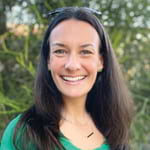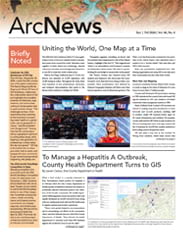In the 1990s, when the first GIS classes were being developed, GIS was taught using command-line interface software, and entire lectures were dedicated to explaining how spatial data has coordinates that are linked to places on Earth. Things have certainly changed! Now, decades later, graphical user interfaces have replaced command-line operations, and high-performance computing and AI are extending the analytical capabilities of GIS, making it possible to perform spatial queries and feature extraction with just a few clicks.
The world is also now awash in spatial data. The proliferation of GPS technology in smartphones and other mobile devices means that massive volumes of spatial data are being collected every day on everything from people’s daily commuting patterns to weather and air pollution. This location data, coupled with imagery from Earth observation satellites and other aircraft, are creating rich opportunities for spatial analysis that could not be imagined when GIS was first being taught. For example, ArcGIS Living Atlas of the World makes it possible to easily access thousands of curated data layers, while a growing number of spatial apps provide spatial data over broad scales.
Additionally, there are more ways to apply GIS than ever before, which means that larger numbers of more diverse people need to be trained in the technology and science of GIS. Given the level of change that has occurred in this world with respect to technology and data, it is also time to rethink how GIS is being taught.
Faculty members in the Center for Spatial Studies and Data Science at the University of California, Santa Barbara (UCSB), are partnering with Esri to convene a conversation on how geographic information science (GIScience) curricula should evolve. Supported by a diverse advisory council, the team will generate updated learning outcomes and publicly available materials that can be used in GIS courses. While this project is just beginning, here is some initial guidance on foundations to consider incorporating into GIS teaching.
What Is Being Taught in GIS—and to Whom—Is Changing
For the purpose of curriculum development, it can be helpful to differentiate between GIS “users” and GIS “makers.” Much like in statistics, which offers different levels of theoretical training to students who simply want to use statistics in their projects and those who want to develop new statistical algorithms, GIS training should also consider learners along similar tracks.
Applied users of GIS need the skills to be able to evaluate the quality of existing spatial data, ask and answer spatial questions, work in web- and cloud-based computing platforms, and interpret spatial analytical results. Meanwhile, GIScientists, or the makers and developers of the science of GIS, need deep conceptual knowledge of underlying algorithms, spatial data creation, data research basics, projections, and high-performance computing. Taking these two types of learners into consideration, educators can begin to rethink which critical skills and competencies are necessary to include in introductory and topical courses and what content might be better suited to more specialized and advanced courses.
GIS learners need to be diverse as well in terms of their backgrounds, histories, and lived experiences. While diversifying science, technology, engineering, and math (STEM) fields is a job for all the sciences, GIScience is in a particularly powerful position to attract diverse participants because of the nature of the questions that can be addressed and the creativity that can be nurtured through visualization and cartography.
The goal of GIS as a field of study should be that anyone can learn the technology, regardless of their demographics or circumstances. Everyone should have access to the power of GIS, which means that GIS curricula and teaching should be inclusive and support people from a wide range of backgrounds and situations. Partnering with organizations that are led by people who are underrepresented in GIS is a good start. For example, NorthStar of GIS—an organization with Black leadership—is working toward developing a racially just world through racially just geography. The organization offers a broad array of resources that GIS teachers can leverage.
The Heightened Importance of Spatial Thinking for Decision-Making
It might seem obvious, but all GIS courses, learning materials, and curricula should emphasize spatial thinking, which leverages the properties of space to structure problems, question why objects are located where they are, find answers, and express solutions.
Given the proliferation of both spatial data and data science, GIS training should focus on spatially explicit approaches that nurture students’ spatial thinking skills. These approaches include teaching students about neighborhood effects, spatial autocorrelation, and the modifiable area unit problem (MAUP), among other concepts. Understanding how to work with the geographic elements of spatial data should be a key learning objective, as it differentiates GIS training from more general training in data science.
Embedded in geography, GIS has long benefited from geographic systems thinking and interdisciplinary perspectives. Within this context, GIS has developed as a foundational tool for decision-making. Given the range of challenges that society and the planet face, GIS curricula should center on project- and problem-based learning that teaches students how to solve complex problems through spatial thinking. Since GIS is a fundamental tool for creating a desirable world, students should be exposed to this type of learning from the start.
To be sure, much of what is being taught in GIS courses will not change. Students still need to learn how to integrate and query spatial datasets. They still need to learn how to build buffers, define spatial neighborhoods, and consider issues of scale. However, educators must recognize that not every user needs the same level of GIS knowledge. As some of the fundamentals have moved to the back end of GIS software, there is now space to focus on problem-based learning, and it is up to educators to capitalize on this opportunity.
Cultivating Excitement for GIS and Spatial Thinking
Since the 1990s, when the original GIS core curriculum was developed, GIS technology has changed, as has the world. GIS curricula must also now adapt and evolve.
There is a massive opportunity to engage more people—and more diverse groups of people—in spatial thinking, GIS, and geographic systems thinking. The more that educators can cultivate excitement for GIS and spatial thinking skills, the more prepared the world will be to handle the challenges ahead.
We at UCSB’s Center for Spatial Studies and Data Science look forward to leading more conversations about how to evolve GIS curricula and hope that many of you will join the discussion. Watch for events at upcoming conferences, including at the American Association of Geographers’ annual meeting in March and at the Esri User Conference in July, or email spatial-admin@ucsb.edu for more information.



